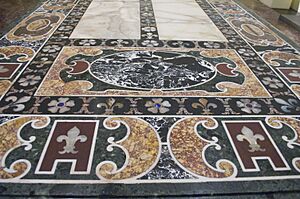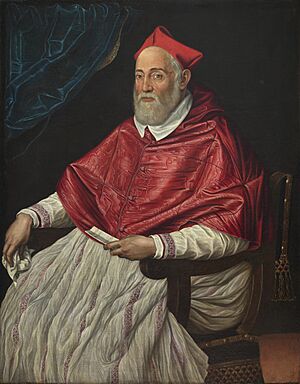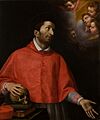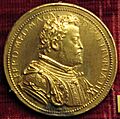Alessandro Farnese (cardinal) facts for kids
Quick facts for kids His Eminence Alessandro Farnese |
|
|---|---|
| Archpriest of Saint Peter's Basilica | |
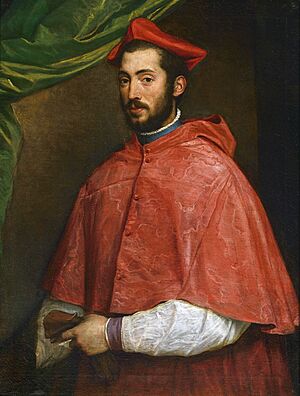
Portrait by Titian, c. 1545-1546
|
|
| Church | Roman Catholic |
| In Office | 1543–1589 |
| Other posts | Dean of the College of Cardinals (1580–89) Cardinal-Bishop of Ostia (1580–89) Cardinal-Priest of San Lorenzo in Damaso (1564–89) |
| Orders | |
| Created Cardinal | 18 December 1534 |
| Rank | Cardinal-Bishop |
| Personal details | |
| Born | 7 October 1520 Castello Valentano, Valentano |
| Died | 2 March 1589 (aged 68) Rome, Papal States |
| Buried | Il Gesù, Rome |
| Nationality | Tuscan |
| Residence | Avignon, Rome |
| Parents | Pierluigi Farnese Girolama Orsini |
| Children | Clelia Farnese |
| Occupation |
|
| Previous post | Cardinal-Bishop of Porto e Santa Rufina (1578–80) Archbishop of Monreale (1568–73) Cardinal-Bishop of Frascati (1565–78) Cardinal-Bishop of Sabina (1564–65) Patriarch of Jerusalem (1539– c. 1550) |
| Education | Bologna (law) |
Alessandro Farnese (born October 7, 1520 – died March 2, 1589) was an important Italian cardinal and diplomat. He was also a big collector and supporter of the arts. He was the grandson of Pope Paul III and the son of Pier Luigi Farnese. Alessandro Farnese should not be confused with his nephew, also named Alessandro Farnese, who was a governor.
Contents
Early Life and Becoming a Cardinal
Alessandro Farnese was born in the family castle in Valentano, Tuscany. His father was Pierluigi Farnese, and his mother was Girolama Orsini. Young Alessandro studied law at Bologna University.
When he was just 14 years old, on December 18, 1534, his grandfather, who had recently become Pope Paul III, made him a Cardinal Deacon. This was a very high position in the Catholic Church. He also received other important church roles, like being in charge of the Tre Fontane Abbey and the Abbey of Saint-Étienne, Caen.
Important Roles and Duties
Cardinal Farnese held many important jobs throughout his life. He became the Vice-Chancellor of the Holy Roman Church, which meant he helped manage a lot of the Pope's business. He was also the Governor of Tivoli and the Archpriest of major churches like St. Mary Major Basilica and St. Peter's Basilica.
At 18, he was named the Latin Patriarch of Jerusalem. This was a title that brought him income, but he didn't have to live there or perform many duties. From 1538 to 1549, he was Pope Paul III's main secretary, helping with most papal affairs.
He was also named the Protector of the Holy Roman Empire and Spain before the Holy See. This meant he handled important matters for these powerful empires in Rome. He also served as a Papal Legate (the Pope's special representative) in Avignon, France, for many years.
Later in his life, he became a Cardinal-Bishop, holding different bishoprics like Sabina, Tusculum (Frascati), and Porto. Finally, he became the Cardinal-Bishop of Ostia and Velletri and the Dean of the College of Cardinals, which is the leader of all the cardinals.
Church Income and Administration
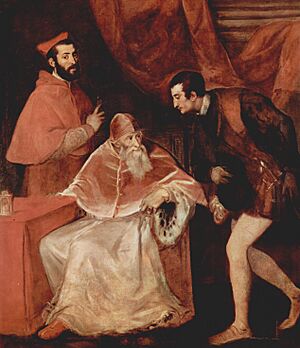
Alessandro Farnese received income from many church areas. His grandfather, Pope Paul III, made him the Administrator of the Diocese of Parma. This allowed him to collect money from that area. He also administered dioceses in Spain, France, and Portugal.
He was appointed Archbishop of Monreale in Sicily. He allowed the Jesuits to start a college there. He visited Monreale in 1568 and held a meeting for the church leaders there. He continued to receive income from this diocese until 1573.
These appointments were often ways for cardinals to gain wealth, as they didn't always require them to be physically present. Instead, they had agents manage the areas for them.
Diplomatic Missions
Cardinal Farnese was a skilled Papal Legate, meaning he was sent by the Pope to represent him in important negotiations. He tried to make peace between the powerful Emperor Charles V, Holy Roman Emperor and King Francis I of France, who were often at war. He traveled to Paris and Flanders for these peace talks in 1539-1540 and again in 1543-1544.
In 1546, he even joined the troops sent by the Pope to help Charles V in a conflict.
In 1551, Pope Julius III asked Cardinal Alessandro to convince his brother, Ottavio, to give up his lands in Parma and Piacenza. The Pope claimed these lands belonged to the Church. However, the Farnese family had worked hard to build their dukedom, and Alessandro supported his brother in refusing the Pope's demand. This caused a big disagreement between Alessandro and the Pope.
Papal Elections (Conclaves)
A Papal conclave is a meeting where cardinals elect a new Pope. Cardinal Farnese was involved in several important conclaves.
Conclave of 1555
After Pope Julius III died in 1555, two conclaves were held. Alessandro Farnese was in Avignon during the first one, but he rushed to Rome. The first conclave elected Cardinal Marcello Cervini, who became Pope Marcellus II. Sadly, Pope Marcellus II died very soon after, just 22 days later.
A second conclave was then needed. Cardinal Farnese played a key role in this election. He and other cardinals decided to support Cardinal Gian Pietro Carafa. Despite some opposition, Carafa was elected Pope on May 23, 1555, and took the name Paul IV.
Conclave of 1559
After Pope Paul IV died in 1559, a new Pope needed to be chosen. King Philip II of Spain and King François II of France each had their preferred candidates. Cardinal Farnese, who was 38 and a senior cardinal, wanted to see Cardinal Carpi elected. He worked with other cardinals, and eventually, Cardinal Giovanni Angelo de' Medici was elected. He became Pope Pius IV. Cardinal Farnese had the honor of crowning the new Pope.
Conclave of 1566
Pope Pius IV died in 1565. Again, different European rulers had their favorites for the next Pope. Cardinal Farnese was also hoping to be elected himself. There were many cardinals, and they were divided into several groups.
Cardinal Carlo Borromeo, a nephew of the late Pope, worked with Cardinal Farnese. They discussed different candidates. Farnese suggested a few names, including Cardinal Michele Ghislieri. Borromeo was very happy with Ghislieri. Within a few hours, they had enough votes. On January 7, 1566, Ghislieri was elected Pope and took the name Pope Pius V.
Conclave of 1572
The Battle of Lepanto, a big naval victory against the Ottoman Turks in 1571, was fresh in everyone's minds. Cardinals wanted a Pope who could continue to lead against the Turks and also enforce the rules of the Council of Trent.
Cardinal Farnese believed this conclave was his chance to become Pope. However, the Spanish king, Philip II, did not want him to be Pope "this time." So, Farnese's chances ended quickly. The cardinals elected Ugo Boncompagni, who became Pope Gregory XIII.
Conclave of 1585
Pope Gregory XIII died in 1585. Cardinal Farnese, at 64, was the most senior cardinal present. However, he wasn't leading a big group of cardinals this time. After some discussion, the cardinals quickly elected Cardinal Felice Peretti Montalto, who became Pope Sixtus V. Farnese was persuaded to agree to this choice.
Patron of Arts and Collector
Alessandro Farnese is famous for his incredible collection of Roman sculptures. This collection is now mostly in Naples. He was very generous to artists, creating a kind of art school at his home, the Villa Farnese at Caprarola, and at the Palazzo Farnese in Rome.
He hired the best sculptors to restore ancient artworks with great care. He also supported living artists, including the famous painter El Greco. His librarian, Fulvio Orsini, helped him organize and expand his collections. Farnese collected old coins and ordered new medals. He owned paintings by famous artists like Titian, Michelangelo, and Raphael.
He also commissioned a beautiful illuminated manuscript called the Farnese Hours, which took nine years to complete. In 1550, he created the Farnese Gardens in Rome, which became one of Europe's first botanical gardens.
Family Life
Cardinal Alessandro Farnese had a daughter named Clelia Farnese, born in 1556. She later married Giangiorgio Cesarini and had a son named Giuliano. After her first husband died, Clelia married Marco Pio di Savoia. Clelia died in 1613.
Death and Burial
Cardinal Alessandro Farnese became very ill in 1588. He suffered from severe breathing problems and gout. He died peacefully in Rome on March 2, 1589, at the age of 68.
He was buried in the Church of the Gesù in Rome. This church was built through his generosity and is a major monument of the Counter-Reformation. An inscription inside the church honors him for helping establish the Jesuit Order and building the church for them.
Images for kids
-
Pope Paul IV, c. 1556
See Also
 In Spanish: Alejandro Farnesio (cardenal) para niños
In Spanish: Alejandro Farnesio (cardenal) para niños
- Onuphrius Panvinius (1529–1568), "de vita Pont. Pauli III," in B. Platina, Historia B. Platinae de vitis Pontificum Romanorum (Cologne: Josue Cholin 1600), 385-405. There is an Italian translation in: Storia delle vite de' Pontefici di Bartolommeo Platina e d' altri autori edizione novissima IV (Venezia: Domenico Ferrarin 1765), pp. 44–70.
- Stefan Bauer, The Invention of Papal History: Onofrio Panvinio between Renaissance and Catholic Reform (Oxford: Oxford University Press 2020).
- Lorenzo Cardella, Memorie de' Cardinali della Santa Romana Chiesa IV (Roma: Pagliarini 1793), pp. 136–140.
- Annibal Caro, Delle Lettere del Commendatore Annibal Caro scritte a nome del Cardinale Alessandro Farnese 3 volumes (Milano 1807).
- Ireneo Affò, La vita di Pier Luigi Farnese (Milano: Giusti 1821).
- Flaminio Maria Annibali, Notizie storiche della casa Farnese 2 parts (Montefiascone 1818).
- Camillo Trasmondo Frangipani, Memorie sulla vita e i fatti del Cardinale Alessandro Farnese (Roma: Sinimberghi 1876).
- G. Drei, I Farnesi. Grandezza e decadenza di una dinastia (Roma 1954).
- G. Rabbi Solari, Storie di casa Farnese (Milano: Mondadori 1964).
- E. Nasalli-Rocca, I Farnesi (Milano: Dall'Oglio 1969).
- Edoardo del Vecchio, I Farnese. (Roma: Istituto di studi romani editore 1972).
- Clare Robertson, 'Il Gran Cardinale'. Alessandro Farnese, Patron of the Arts. New Haven: Yale University Press, 1992.
- Helge Gamrath, Farnese: Pomp, Power and Politics in Renaissance Italy (Roma: Bretschneider 2007).
- Arnold Alexander Witte, The Artful Hermitage: The Palazzetto Farnese as a Counter-reformation Diaeta (Roma: Bretschneider 2008).
- Papal conclave, 1549-1550. Sede Vacante and Conclave of 1549--1550 (Dr. J. P. Adams).
- Self-published papers concerning the Farnese, by Patrizia Rosini, at https://independent.academia.edu/patriziarosini/Papers
- Patrizia Rosini, La malattia del Cardinale Alessandro Farnese (2008).


